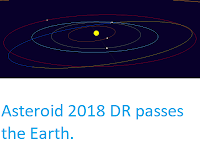Asteroid 2017 VR12 passed by the Earth at a distance of about 1 445 000
km (3.76 times the average distance between the Earth and the Moon, or 0.97% of the distance between the Earth and the Sun), slightly before 7.55 am
GMT on Wednesday 7 March 2018. There was no danger of
the asteroid hitting us, though were it to do so it would have
presented a significant threat. 2017 VR12 has an estimated
equivalent
diameter of 1040-450 m (i.e. it is estimated that a spherical object
with
the same volume would be 140-450 m in diameter), and an object of this
size would be predicted to be capable of
passing through the Earth's
atmosphere relatively intact, impacting the ground directly with an
explosion that would be 8250 to 175 000 times as powerful as the
Hiroshima
bomb. Such an impact would result in an impact crater 2-8 km
in
diameter
and devastation on a global scale, as well as climatic effects that
would last decades or even centuries.
Short animation of 2017 VR12 (still object at centre of image). Animation made up of 120 individual images taken on 7 March 2018, when the asteroid was at its closest. Gianluca Masi/Virtual Telescope/Michael Swartze/Tenegra Observatory.
2017 VR12 was discovered on 10 November 2017 by the University of Hawaii's PANSTARRS
telescope on Mount Haleakala on Maui. The designation 2017 VR12 implies
that it was the 317th asteroid (asteroid R12) discovered in the first
half of November 2017 (period 2017 V).
The calculated orbit of 2017 VR12. Minor Planet Center.
2017 VR12 has a 585 day orbital period and an eccentric orbit
tilted at an angle of 9.22° to the plane of the Solar System, which
takes it from 1.00 AU from the Sun (i.e. the average distance at
which the Earth orbits the Sun) to 1.73 AU from the Sun (i.e. 173% of the
average distance at which the Earth orbits the Sun, and more distant from the Sun than the planet Mars). It is therefore
classed as an
Apollo Group Asteroid (an asteroid that is on average further from the
Sun than the Earth, but which does get closer). This means that close
encounters between the asteroid and Earth are extremely common, with the
last having occurred in June 2010 and the next predicted
in March 2026. As an asteroid probably larger than 150 m in diameter
that occasionally comes within 0.05 AU of the Earth, 2017 VR12 is also
classified as a Potentially Hazardous Asteroid.
See also...
Follow Sciency Thoughts on Facebook.








